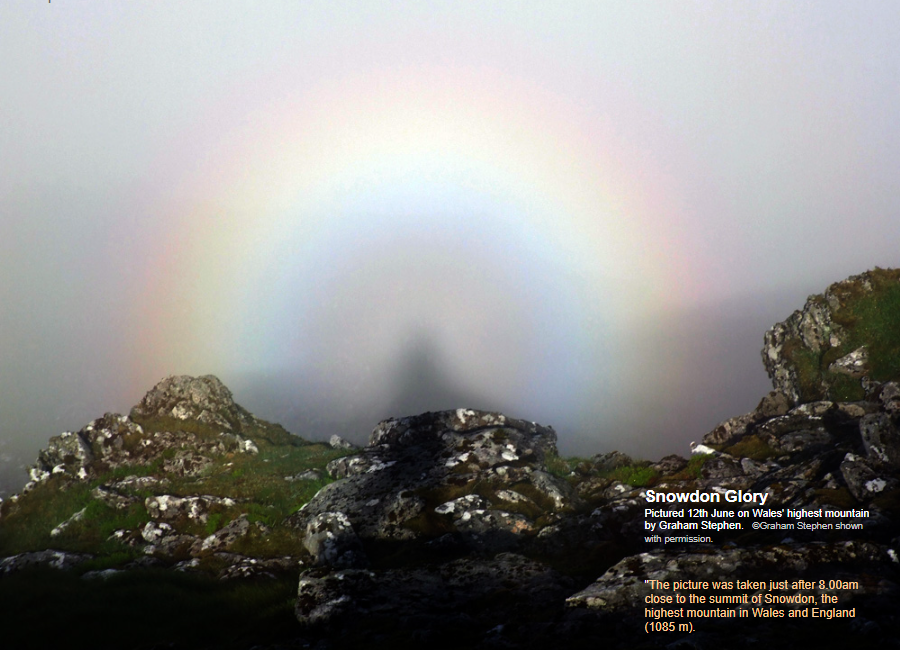Snowdon Glory
Snowdon Glory: A Spectacular Atmospheric Phenomenon
The Snowdon Glory is a breathtaking atmospheric phenomenon that occurs on the summit of Snowdon, the highest mountain in Wales and England. This stunning spectacle was captured by Graham Stephen, who managed to photograph the elusive Brocken Spectre and Glory. These optical phenomena are transient in nature, requiring quick reflexes and patience to capture them in all their glory.
The picture taken by Graham Stephen showcases the delicate and vibrant colors of the first ring of the glory. Although images cannot fully capture the shimmer and sparkle of glories, this photograph successfully conveys their magnificence. In comparison, the Mie computation by IRIS at left provides an exact calculation of the glory's appearance, but falls short in capturing its true beauty.
Glories are formed when sunlight is diffracted by mist droplets in the atmosphere. This diffraction causes the light to scatter and create a circular ring of colors around the shadow of the observer. The shadow itself, known as the Brocken Spectre, is a 3D tunnel of shadow cast through the mist. In this particular image, the rocks on either side of the shadow also cast similar shadow tubes that appear to converge towards the antisolar point.
To capture this awe-inspiring phenomenon, Graham Stephen had to wait patiently for gaps in the cloud cover to allow the sun to shine through. This required enduring freezing winds for about fifteen minutes. The evanescent nature of glories means they can vanish as quickly as they appear, making it crucial to seize the moment when they manifest.
The Snowdon Glory serves as a reminder of the wonders that can occur in our atmosphere. It showcases the interplay between light, mist droplets, and shadows, creating a spectacle that leaves viewers in awe. As with many atmospheric optics, glories are unpredictable and elusive, making each sighting a truly special experience.
For those interested in witnessing the Snowdon Glory for themselves, it is essential to visit Snowdon's summit and be prepared to patiently wait for the right conditions. The mountain's high elevation and unique weather patterns provide an ideal environment for the formation of glories. However, it is important to note that these phenomena are not guaranteed and require a combination of mist, sunlight, and the observer's position to align perfectly.
In conclusion, the Snowdon Glory is a remarkable atmospheric phenomenon that showcases the beauty and complexity of our atmosphere. It is a transient spectacle that requires both luck and perseverance to witness and capture. Graham Stephen's photograph provides a glimpse into the delicate colors and shimmering nature of glories, while reminding us of the captivating wonders that can occur in our skies. So, if you find yourself near Snowdon's summit on a misty day, keep your eyes peeled for this elusive phenomenon and be ready to embrace the marvels of atmospheric optics.

Snowdon Glory
Pictured 12th June on Wales' highest mountain by Graham Stephen. ©Graham Stephen shown with permission.

"The picture was taken just after 8.00am close to the summit of Snowdon, the highest mountain in Wales and England (1085 m).
On the path from Hafod Eryri down towards the South ridge I was suddenly confronted by a marvelous Brocken Spectre and Glory.
Unfortunately, by the time I got my camera out it had disappeared. So, I waited around in the freezing wind for about a quarter of an hour for gaps in the cloud covering the sun. This picture and a couple of others are the results from when it did momentarily shine through."
Glories, like many sky optics, are evanescent and needs be captured the instant they appear.
Images do not capture how glories shimmer and sparkle but Graham's picture has caught the delicacy of the first ring colours magnificently. Compare them with the Mie computation by IRIS at left. The calculation is exact but my translation of all the individual wavelength components into three monitor RGB values has left much to be desired!
Sunlight diffracted by mist droplets has created the glory.
The shadow or Brocken Spectre is a 3D tunnel of shadow cast through the mist. The rocks at left and right are casting similar shadow tubes that also appear to converge towards the antisolar point.
Note: this article has been automatically converted from the old site and may not appear as intended. You can find the original article here.
Reference Atmospheric Optics
If you use any of the definitions, information, or data presented on Atmospheric Optics, please copy the link or reference below to properly credit us as the reference source. Thank you!
-
<a href="https://atoptics.co.uk/blog/snowdon-glory/">Snowdon Glory</a>
-
"Snowdon Glory". Atmospheric Optics. Accessed on May 2, 2024. https://atoptics.co.uk/blog/snowdon-glory/.
-
"Snowdon Glory". Atmospheric Optics, https://atoptics.co.uk/blog/snowdon-glory/. Accessed 2 May, 2024
-
Snowdon Glory. Atmospheric Optics. Retrieved from https://atoptics.co.uk/blog/snowdon-glory/.